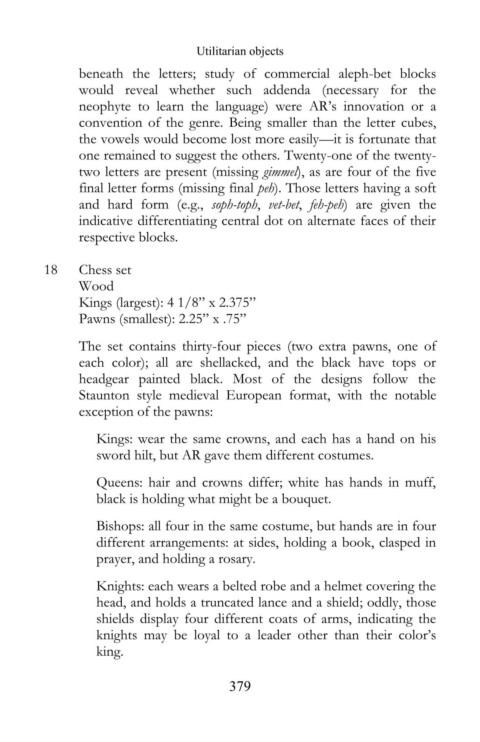Page 383 - The Legacy of Abraham Rothstein - text
P. 383
Utilitarian objects
beneath the letters; study of commercial aleph-bet blocks
would reveal whether such addenda (necessary for the
neophyte to learn the language) were AR’s innovation or a
convention of the genre. Being smaller than the letter cubes,
the vowels would become lost more easily—it is fortunate that
one remained to suggest the others. Twenty-one of the twenty-
two letters are present (missing gimmel), as are four of the five
final letter forms (missing final peh). Those letters having a soft
and hard form (e.g., soph-toph, vet-bet, feh-peh) are given the
indicative differentiating central dot on alternate faces of their
respective blocks.
18 Chess set
Wood
Kings (largest): 4 1/8” x 2.375”
Pawns (smallest): 2.25” x .75”
The set contains thirty-four pieces (two extra pawns, one of
each color); all are shellacked, and the black have tops or
headgear painted black. Most of the designs follow the
Staunton style medieval European format, with the notable
exception of the pawns:
Kings: wear the same crowns, and each has a hand on his
sword hilt, but AR gave them different costumes.
Queens: hair and crowns differ; white has hands in muff,
black is holding what might be a bouquet.
Bishops: all four in the same costume, but hands are in four
different arrangements: at sides, holding a book, clasped in
prayer, and holding a rosary.
Knights: each wears a belted robe and a helmet covering the
head, and holds a truncated lance and a shield; oddly, those
shields display four different coats of arms, indicating the
knights may be loyal to a leader other than their color’s
king.
379

